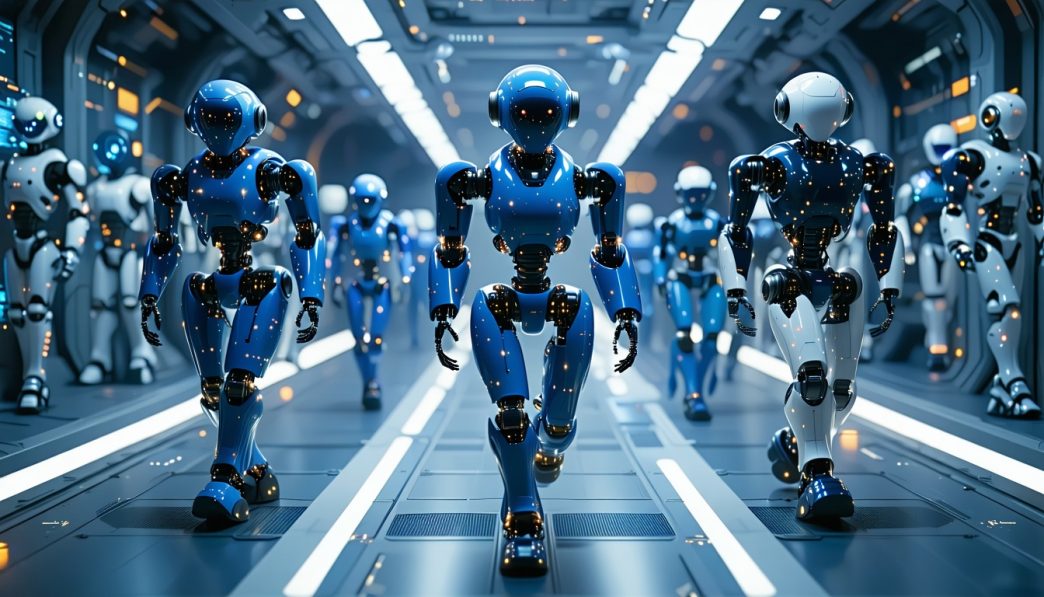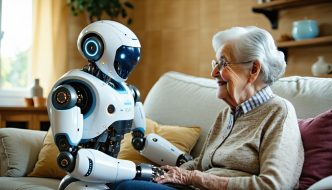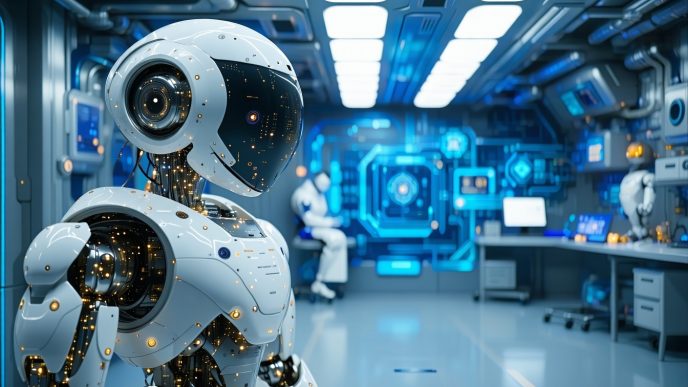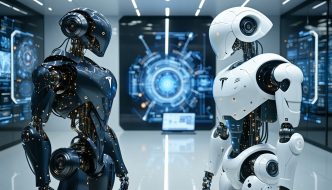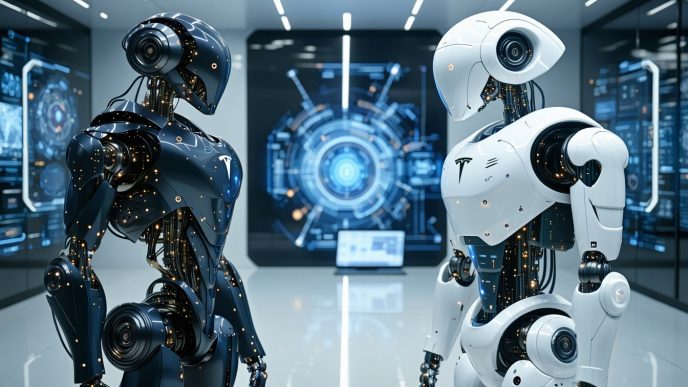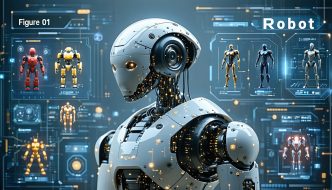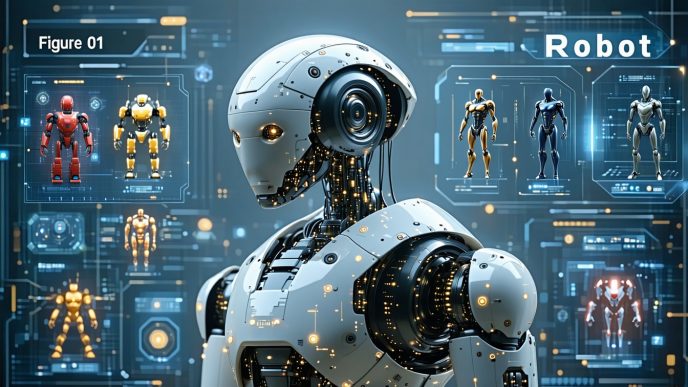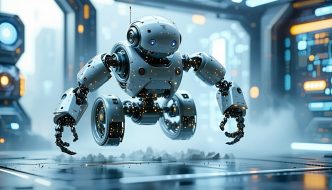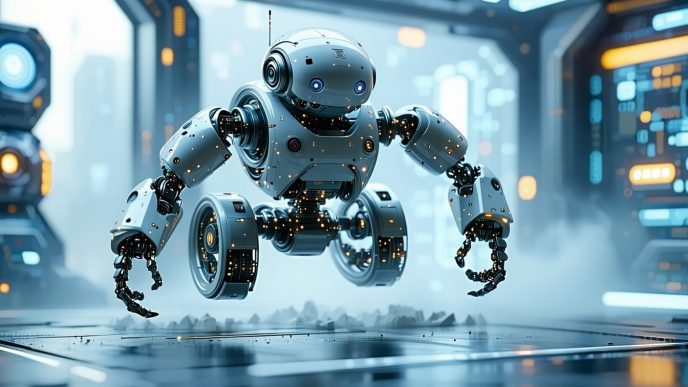The Evolution of Humanoid Robots
Overview of Humanoid Robots
Humanoid robots are designed to mimic human form and behavior, with the intent of interacting with humans in ways that feel natural. These robots often feature human-like characteristics including a torso, head, arms, and legs, allowing for a range of movements and interactions. Over the years, several models have emerged, showcasing varying degrees of functionality and sophistication, from basic robots like Agility Digit Robot to advanced designs such as the Tesla Optimus Robot.
| Robot Model | Key Features |
|---|---|
| Tesla Optimus | Autonomous navigation, AI integration |
| Sanctuary AI Phoenix | Advanced conversational capabilities |
| Apptronik Apollo | Human-like dexterity and movement |
| Agility Digit | Focus on mobility and agility |
| Xiaomi CyberOne | Emotion recognition, interactive features |
The design of humanoid robots aims not just for visual similarity, but also functional interaction within human environments, such as in homes or workplaces. The ability to navigate these spaces effectively relies heavily on the development of sophisticated humanoid robot locomotion systems.
Importance of Mobility in Humanoid Robots
Mobility is a fundamental aspect of humanoid robots that enhances their ability to perform tasks and interact with humans. It allows them to move, react, and adapt to various environments, making them more useful in a variety of settings from home assistance to healthcare.
Effective mobility in humanoid robots enables:
- Interaction: Moving around freely allows robots to engage with humans and objects, enhancing their utility in roles such as companionship and caregiving.
- Task Performance: Robots with advanced locomotion can carry out tasks that require movement, such as delivering items or performing household chores. Models like humanoid robots for daily chores exemplify this utility.
- Adaptability: Mobility allows robots to navigate complex environments, making them versatile across different applications, including logistics and healthcare.
Various locomotion strategies and systems are implemented to achieve efficient movement. For instance, the understanding of biomechanics and the development of software algorithms play a crucial role in simulating human-like motion. This extensive focus on mobility is essential for the continuous evolution of humanoid robots, ensuring they remain relevant and effective in their designated roles. For a deeper dive into the advancements in humanoid robot mobility, see our section on human-inspired locomotion.
Principles of Locomotion
Understanding the principles of locomotion in humanoid robots involves studying how they mimic human movement and the various engineering challenges they face.
Biomechanics and Human Movement
Biomechanics is the study of the mechanical laws relating to the movement or structure of living organisms. Humanoid robots are designed to replicate human biomechanics, implementing movements such as walking, running, and climbing. Key aspects of biomechanics include:
| Human Movement Aspect | Description |
|---|---|
| Gait Cycle | The pattern of movement of the limbs during locomotion. |
| Joint Flexibility | The degree of movement in joints that enables various motions. |
| Balance Mechanisms | Systems that maintain stability and prevent falling. |
By analyzing these aspects, engineers can develop humanoid robot locomotion systems that enhance mobility and functionality.
Engineering Challenges in Robot Mobility
Creating efficient humanoid robot locomotion systems presents numerous engineering challenges. Key issues include:
| Challenge | Description |
|---|---|
| Stability | Ensuring robots can maintain balance while moving or performing tasks. |
| Energy Efficiency | Reducing power consumption during movement while maximizing performance. |
| Sensor Integration | Implementing sensors that allow robots to navigate environments effectively. |
| Adaptability | Designing robots that can adjust their movements based on varying terrains and obstacles. |
Addressing these engineering concerns is essential for developing practical and advanced humanoid robots capable of performing complex tasks. Exploring humanoid robot navigation can provide additional insights into overcoming mobility challenges.
Bipedal vs. Multi-Legged Robots
In the realm of humanoid robots, two primary locomotion types exist: bipedal and multi-legged robots. Each category has its own unique set of advantages and disadvantages, as well as diverse locomotion systems that are essential for their functionality.
Advantages and Disadvantages
| Feature | Bipedal Robots | Multi-Legged Robots |
|---|---|---|
| Movement Efficiency | Mimics human movement, efficient | Stable on uneven terrain |
| Complexity | Less complex design | More complex with more control points |
| Energy Consumption | Generally lower energy consumption | May require more power |
| Adaptability | Limited adaptability in rough terrain | Highly adaptable to various terrains |
| Footprint Size | Smaller footprint | Larger footprint |
| Stability | Can be unstable, prone to falling | More stable with multiple legs |
Bipedal robots, such as those mimicking human gait, are designed to imitate the leg movement of humans, which can offer a sense of familiarity and efficiency in human environments. However, they can struggle with stability and balance on uneven surfaces.
On the other hand, multi-legged robots benefit from their design when navigating rough terrains, providing them superior stability. Yet, they often require more advanced engineering to manage the coordination of multiple legs.
Comparison of Locomotion Systems
Locomotion systems vary significantly between bipedal and multi-legged robots, leveraging different mechanics and designs:
| Locomotion System | Bipedal Robots | Multi-Legged Robots |
|---|---|---|
| Gait Patterns | Walk, run, and jump | Crawl, walk, or hop |
| Joint Mechanism | Limited joints (knees, hips) | Multiple joints (ankles, knees) |
| Control Systems | Simplified control logic | Complex control algorithms |
| Sensors | Primarily balance sensors | Combined sensors for stability and navigation |
Bipedal robots typically utilize simple gait patterns, integrating control mechanisms that can imitate the agility of human movement. Multi-legged robots, however, adopt more complex gaits that require sophisticated control systems to coordinate leg movements effectively.
Overall, both types of humanoid robot locomotion systems demonstrate unique advantages and capabilities. The decision between bipedal and multi-legged designs often depends on the intended use case for the robot, whether navigating human environments or traversing uneven landscapes. For further insights into humanoid robots’ functionalities, explore the article on humanoid robot navigation.
Human-Inspired Locomotion
Humanoid robots aim to replicate human-like movement to enhance interaction with people and environments. This section explores the techniques used to mimic human gait and the adoption of bio-inspired approaches to locomotion.
Mimicking Human Gait
The human gait is characterized by a unique and complex pattern of movement. Human biomechanics involve not only the legs but also the arms, torso, and overall body dynamics. When designing humanoid robots, engineers study this intricate movement to develop effective locomotion models. Emulating human gait allows robots to navigate spaces designed for people, increasing their functionality.
A typical human gait can be broken down into phases:
| Phase | Description |
|---|---|
| Stance | The foot is on the ground, supporting the weight. |
| Swing | The foot is off the ground, moving forward. |
| Heel Strike | The heel contacts the ground first. |
| Toe Off | The toes leave the ground to propel the body forward. |
The goal is for robots to achieve a walking pattern that closely resembles this sequence, ensuring stability and efficiency on various terrains. Understanding these phases aids in the development of effective humanoid robot locomotion systems.
Bio-Inspired Approaches to Locomotion
In addition to mimicking human movement, engineers often draw inspiration from the natural world to create effective locomotion strategies. Various animals exhibit unique ways of moving that can be beneficial for humanoid robots.
Bio-inspired approaches leverage designs and mechanisms observed in nature to enhance robot mobility. For example, some robots utilize joint structures and movement patterns similar to those in different animals, allowing for greater adaptability and efficiency.
| Inspiration Source | Key Feature | Application in Robotics |
|---|---|---|
| Birds | Lightweight, flexible wings | Energy-efficient aerial mobility |
| Insects | Multi-legged movement strategies | Enhanced stability and agility |
| Cheetahs | Fast, agile running | Improved speed and quick directional changes |
By analyzing these biological systems, engineers can implement novel technologies in humanoid robots that improve their locomotion capabilities, enabling them to traverse a variety of environments. Such advancements in humanoid robot locomotion systems are essential for enhancing the robots’ applicability in sectors such as healthcare, education, and domestic tasks. For instance, humanoid robots designed for elder care can benefit significantly from these bio-inspired designs, allowing them to assist users with greater ease and efficiency.
Continued research in this field promises exciting developments that could redefine the capabilities of humanoid robots, making them more effective companions and helpers in everyday life.
Engineering Solutions for Stability
Stability in humanoid robots is critical for effective movement and performance. Engineers have developed various solutions to ensure that these robots can maintain balance and navigate their environments safely.
Dynamic Balancing
Dynamic balancing is a sophisticated approach that mimics the way humans and animals maintain their balance while moving. This technique involves constant adjustments to the robot’s posture based on real-time data from its environment. By leveraging algorithms that replicate human reflexes, dynamic balancing allows robots to make quick corrections to prevent falls.
Dynamic balancing systems typically utilize feedback loops that analyze the robot’s position and the forces acting upon it. Sensors play a vital role in this process, providing data about orientation and motion. These systems are often integrated into humanoid robot locomotion systems, enabling them to walk, run, or even navigate obstacles effectively.
| Dynamic Balancing Features | Description |
|---|---|
| Real-time Feedback | Adjustments based on immediate data |
| Adaptive Algorithms | Mimics human reflexes for stability |
| Posture Correction | Quick response to maintain balance |
Sensor Technologies for Stability Control
Sensor technologies are essential for ensuring that humanoid robots remain stable during movement. These sensors gather critical information about the robot’s position, orientation, and external environment. Some common types of sensors used in humanoid robots include:
- Gyroscopes: Measure angular velocity to determine orientation changes.
- Accelerometers: Detect changes in motion and help sustain balance.
- Lidar and Cameras: Provide spatial awareness to navigate surroundings.
Integrating these sensors allows humanoid robots to continuously monitor their stability and make necessary adjustments. By utilizing sophisticated sensor fusion techniques, engineers can combine data from multiple sources to enhance the accuracy of stability control systems.
| Sensor Type | Functionality |
|---|---|
| Gyroscope | Measures orientation and tilt |
| Accelerometer | Detects acceleration and deceleration |
| Lidar | Maps surroundings and detects obstacles |
| Cameras | Provides visual feedback for navigation |
The effective implementation of dynamic balancing and advanced sensor technologies is crucial for the development of humanoid robot locomotion systems. By equipping robots with these capabilities, engineers are addressing significant challenges in stability, paving the way for more agile and reliable humanoid robots. For more on how these solutions enhance robot abilities, refer to our article on humanoid robot locomotion systems.
Locomotion Strategies
Humanoid robot locomotion systems are designed to enable robots to move in a manner similar to humans. This involves various strategies focused on walking, running, turning, and maneuvering. Understanding these strategies is essential for enhancing the performance of humanoid robots in various environments.
Walking and Running Gaits
Walking and running are fundamental forms of mobility for humanoid robots. Each gait has specific characteristics that influence stability and efficiency.
| Gait Type | Description | Speed (m/s) | Energy Consumption |
|---|---|---|---|
| Walking | A slow, stable movement involving a shift of weight from one foot to the other. | 1.0 – 2.0 | Low |
| Running | A faster gait where both feet leave the ground in alternate phases. | 2.5 – 5.0 | Moderate to High |
The design of the robot’s limb mechanics and control systems plays a critical role in determining the success of these gaits. For example, walking often requires coordination between limbs and the use of sensors to maintain balance, while running requires more complex algorithms to manage speed and stabilization.
Turning and Maneuvering Techniques
Turning and maneuvering are vital for humanoid robots, especially in dynamic environments where navigation is required. Robots must execute turns with precision to avoid obstacles.
Turning Techniques
- Pivot Turn: The robot rotates around one foot, similar to how humans pivot on a foot.
- Step Turn: The robot takes a step in the direction of the turn before pivoting.
Maneuvering Techniques
- Side Stepping: A technique used to navigate around obstacles while maintaining a forward motion.
- Cross-Step: Allows quick direction changes by crossing one leg over the other.
| Technique | Description | Use Cases |
|---|---|---|
| Pivot Turn | Rotates around one foot. | Narrow spaces |
| Step Turn | Steps in turn direction before pivoting. | Wider turns |
| Side Stepping | Moves sideways while facing forward. | Tight areas |
| Cross-Step | Quick directional change. | Rapid adjustments |
The algorithms governing these locomotion strategies are crucial for enhancing the effectiveness of humanoid robots in performing complex tasks. For further reading on how robots navigate their surroundings, check our article on humanoid robot navigation. Understanding different locomotion techniques not only aids in improving robotic movement but can also have implications for future innovations in humanoid designs.
Advanced Locomotion Systems
The ability to navigate complex environments is essential for humanoid robots. Two significant aspects of advanced locomotion systems include walking on uneven terrain and climbing or descending stairs.
Walking on Uneven Terrain
Humanoid robots must adapt their locomotion systems to traverse uneven surfaces, such as gravel, grass, or mixed terrain. This requires sophisticated algorithms and sensor technologies to detect changes in the ground conditions. Implementing dynamic balancing techniques allows robots to adjust their center of gravity, maintaining stability while walking.
Robots equipped with advanced locomotion systems can analyze the environment using sensors that provide data on slope, texture, and surface height. These sensors enable real-time adjustments, ensuring that the robot can maintain balance and navigate obstacles effectively.
Key Features for Walking on Uneven Terrain
| Feature | Description |
|---|---|
| Sensor Integration | Utilizes depth cameras and LiDAR for environment mapping. |
| Adaptive Algorithms | Adjusts gait and posture dynamically based on terrain feedback. |
| Multi-Leg Coordination | Engages multiple legs for improved stability and weight distribution. |
Aptly designed humanoid robots, such as the Agility Digit Robot and Unitree G1 Robot, demonstrate the capability to traverse various terrain types seamlessly.
Climbing and Descending Stairs
Climbing and descending stairs present unique challenges to humanoid robotics. The need for precise movement coordination and timing is crucial to avoid falls. Roboticists have developed advanced locomotion systems that include stair-climbing algorithms and specialized leg configurations to facilitate vertical movement.
These systems often employ a combination of joint rotation and foot placement adjustment to handle step heights and depths effectively. Some robots utilize an additional mechanism, such as grasping or pushing, to stabilize themselves while navigating stairs.
Key Features for Stair Navigation
| Feature | Description |
|---|---|
| Enhanced Joint Mobility | Allows for a wider range of movement, accommodating different stair depths. |
| Gait Adaptation | Adjusts walking patterns to ensure safe ascension and descension. |
| Real-time Feedback | Utilizes accelerometers and gyroscopes for stability control during stair travel. |
Humanoid robots like the Tesla Optimus Robot and Apptronik Apollo are designed with sophisticated stair navigation systems, enabling them to handle real-world scenarios where stairs are commonplace.
The development of humanoid robot locomotion systems capable of walking on uneven terrain and navigating stairs expands their potential applications, making them increasingly versatile in various environments, from homes to workplaces.
Future of Humanoid Robot Mobility
As advancements continue in the field of robotics, the future of humanoid robot mobility shows great promise. Innovations in locomotion systems are at the forefront, enabling these robots to navigate complex environments with ease.
Innovations in Locomotion Systems
Recent developments in humanoid robot locomotion systems involve the integration of advanced technologies that enhance maneuverability and adaptability. Key innovations include:
| Technology | Description |
|---|---|
| Artificial Intelligence | AI algorithms improve decision-making processes for navigation and obstacle avoidance. |
| Machine Learning | Robots learn from past movements, optimizing locomotion strategies for improved efficiency. |
| Soft Robotics | Using materials that mimic the flexibility of human muscles allows robots to move more fluidly. |
| Enhanced Sensor Technologies | Advanced sensors provide real-time feedback, aiding in balance and spatial awareness. |
These innovations not only facilitate walking and running but also include walking on uneven terrain and climbing stairs. As these systems evolve, they will significantly expand the functional capabilities of humanoid robots such as Agility Digit Robot and Xiaomi CyberOne.
Implications for Robotics Industry
The advancements in humanoid robot locomotion systems have far-reaching implications across various sectors of the robotics industry. Increased mobility allows for:
- Enhanced Applications: Humanoid robots can be employed in diverse roles such as elder care, security, and assistance in daily chores humanoid robots for daily chores.
- Market Growth: As humanoid robots become more capable, demand in the consumer market will likely increase, driving innovation and investment.
- Integration with AI: The combination of locomotion systems and AI models in humanoid robots will pave the way for more intuitive interactions with humans.
- Research and Development: Continuous improvement in locomotion will stimulate further research, enhancing both humanoid robot design challenges and technology applications.
- Cost Reduction: More efficient locomotion systems could lead to reduced manufacturing costs, making humanoid robots accessible to a broader audience.
The evolution of humanoid robot mobility will shape the future landscape of robotics, promising exciting possibilities for innovation and collaboration between humans and machines.

